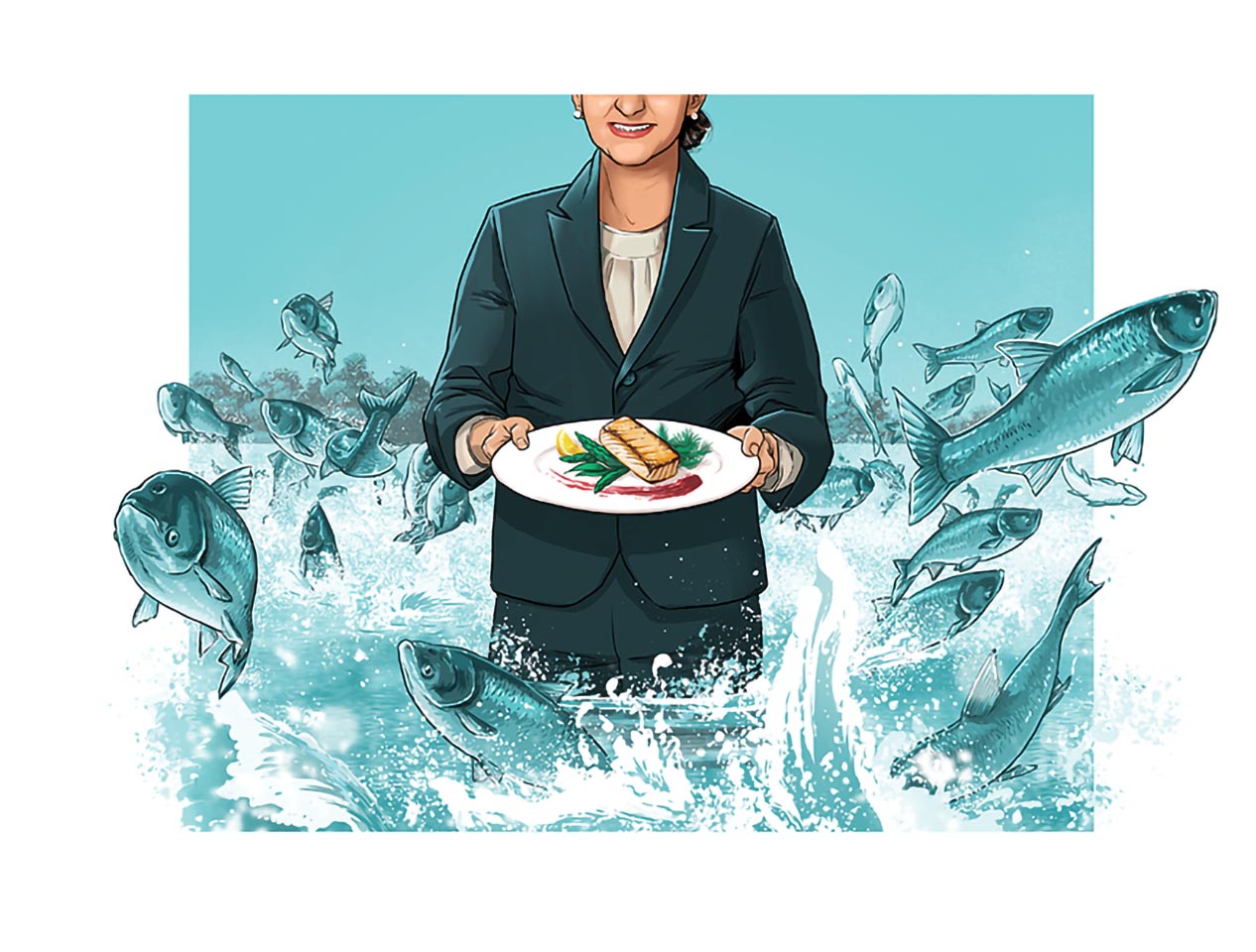Gina Galli ’87 Behnfeldt develops market solutions for invasive species removal.
Copi isn’t yet a household name, but it could be soon. This mild-flavored, versatile fish — previously known as Asian carp — is making waves in restaurants around the Great Lakes, and interest is rippling outward to food companies and retailers all over the U.S. “This fish resonates with so many food-buying trends today,” says Gina Galli ’87 Behnfeldt, vice president of economic development services for global consulting firm Tetra Tech. “It’s wild-caught and responsibly sourced from rivers in the Midwest. It’s really clean in terms of contaminants often found in other edible fish. It’s delicious.” Best of all, she says, the fishers who catch Copi, the businesses that buy and prepare it, and everyone who eats it are all helping to solve a serious ecological challenge.
“These invasive fish are wreaking havoc on Midwestern ecosystems,” Behnfeldt explains. “In some places, they constitute more than 70% of the biomass of rivers and lakes.” They multiply exponentially every year, spreading northward as they out-compete native species for food. If they reach the Great Lakes, they could cause billions of dollars in damage to the region’s ecosystems, commercial fisheries, and overall economy.
The state of Illinois is trying to prevent that from happening. It’s looking at engineering solutions, like physical barriers, as well as creative strategies that employ businesses to help solve the challenge. Behnfeldt specializes in the latter.
“In other parts of the world, top-feeding carp like these are among the most commonly eaten fish species. So when I started this project, my first question was, ‘Why are more businesses not taking advantage of this tremendous, local resource?’”
Working with the Illinois Department of Natural Resources (IDNR), Behnfeldt’s team interviewed local government groups, fishers, and food processors. Three “sticking points” rose to the top: Processors couldn’t secure a consistent supply of these fish; on the other hand, fishers didn’t try to catch them because processors paid so little for them. Any company that incorporated this fish into its business was taking a risk due to carp’s negative image — the general public incorrectly assumed this “hated invader” was a dirty bottom-feeder.
Behnfeldt and her partners developed interrelated programs to alleviate these pain points. The Enhanced Contract Fishing program now provides participating fishers additional compensation for Asian carp they sell to processors, thus incentivizing a more consistent supply. The Market Value Program helps processors defray the costs of marketing Asian carp to restaurants, retailers, and consumer-facing food brands.
“After starting these programs, we turned to another key comment reflected in our interviews — we needed to change the Asian carp’s image,” Behnfeldt says.
“We needed to change the Asian carp’s image.”
Tetra Tech and IDNR brought Illinois-based marketing, PR, and event coordination firms on board to rename Asian carp and create a marketable brand for it. “They conducted market research on food-buying trends and consumer desires, and they tested a variety of names with consumers, marine biologists, fish experts, and food industry professionals. Out of this collaborative effort, ‘Copi’ was created,” Behnfeldt says.
The name, derived from “copious,” reflects the fish’s over-abundant population while spotlighting its numerous benefits. The team launched the brand in June 2022 with a virtual launch event, national news coverage, a social media campaign and website, and a trail of Chicago restaurants that debuted new Copi dishes.
Copi was available in nine states at launch; the team projects it to be sold in 14 states by late 2023/early 2024 as processors continue to ramp up production, more national and regional distributors join the network, and supermarkets get involved.
“As a tool to help address ecological challenges, this project has hit it out of the park,” Behnfeldt says. Since the launch, they’ve removed more than 4 million pounds of Copi from Midwestern waterways.
“It comes down to smart resource use,” Behnfeldt says. “By employing market forces, we’re creating an economy around Copi that will serve as an engine for harvesting these fish — and that will benefit both businesses and the environment.”
Facts about Copi (Asian carp):
- Native to East Asia, they were imported into the U.S. in the 1970s.
- They escaped from confinement into the Mississippi River and spread to major U.S. rivers in Illinois, Indiana, Mississippi, Missouri, Ohio, Tennessee, Kentucky, and many other states.
- They crowd out native species; they make up 70% of fish biomass in some areas.
- They threaten the Great Lakes’ $7 billion fishing industry.
- For eating purposes, they are mild-flavored, clean, top-feeding freshwater fish. They are high in protein and Omega-3 fatty acids and are well below FDA limits for contaminants and heavy metals.
- More than 10 million pounds have been removed since the launch of the Copi campaign, helping to solve a dire ecological problem.

